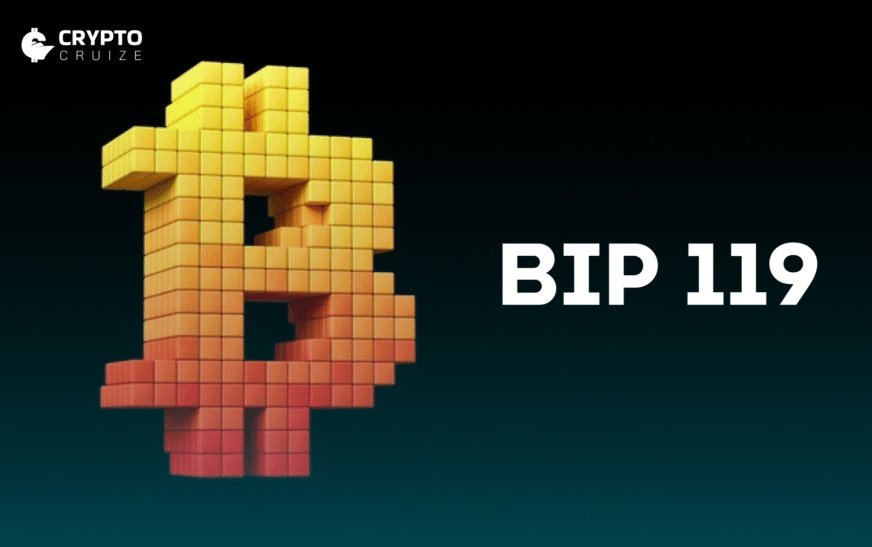Bitcoin may be on the verge of one of its most important upgrades in years. Known as BIP-119, or OP_CHECKTEMPLATEVERIFY (CTV), this long-standing Bitcoin Improvement Proposal has the potential to significantly enhance the network’s scalability, security, and usability.
Originally proposed in 2019 by developer Jeremy Rubin, BIP-119 introduces a feature known as covenants, a way to restrict how Bitcoin can be spent. These changes could enable advanced tools for self-custody, smarter layer-2 systems like Lightning Network and Ark, and even potential bridges to other blockchain ecosystems.

After years of dormancy and community debate, recent developments suggest that BIP-119 could finally move forward with developers hoping to reach consensus by the end of 2025. If implemented, it would mark the first major Bitcoin upgrade since Taproot in 2021.
What is BIP-119 and Why Does It Matter?
At its core, BIP-119 introduces OP_CHECKTEMPLATEVERIFY, an opcode that enables covenants. These covenants let users set rules on how their Bitcoin can be spent, something Bitcoin doesn’t currently support.
This might sound simple, but the implications are vast:
- Users could create “smart vaults” that limit how much Bitcoin can be moved and to where.
- Self-custody becomes safer, reducing the risk of hacks or human error.
- It opens the door for complex smart contracts on Bitcoin’s base layer, which were previously thought too risky or difficult to implement.
- It improves Layer-2 protocols like Lightning and Ark, making them more secure and scalable for everyday payments.

These enhancements could finally make Bitcoin more practical for real-world transactions like buying a coffee without compromising on its core principle as a secure, decentralised store of value.
Developer Support and Community Push
On June 9, 66 respected developers and industry figures signed an open letter calling for adoption of BIP-119 (alongside another proposal, BIP-348). The list includes names like Jameson Lopp, Andrew Poelstra, and developers from companies such as Anchorage, Luxor Mining, and Alpen Labs.
Their letter outlined the “significant benefits” that these upgrades could bring, such as:
- Stronger layer-1 security
- Enhanced layer-2 scaling
- New capabilities like vaults, smart custody, and discreet log contracts
While activation isn’t guaranteed, key voices such as Steven Roose, CEO of Second, have said that a consensus could be reached by year-end.
Daniel Gray, senior analyst at Fidelity Digital Assets, also supports the upgrade, noting that Bitcoin’s self-custody tools would become far more robust with the introduction of covenants.
What Makes Bitcoin Upgrades So Difficult?
Unlike centralised platforms, Bitcoin has no board or leadership to approve changes. Instead, upgrades are adopted only when broad consensus is reached across miners, developers, and node operators. This process is slow by design and for good reason.
Bitcoin is a long-term store of value, and its decentralised nature means decisions must be handled carefully to avoid unintended consequences. The last upgrade, Taproot, took years to activate and later introduced unforeseen uses like Bitcoin NFTs (ordinals), which some developers didn’t anticipate or welcome.

BIP-119 faces similar hurdles. Although Jeremy Rubin initially proposed a “Speedy Trial” method to quickly implement the change via miner approval, critics felt this gave too much power to miners. The User Activated Soft Fork (UASF) relies on Bitcoin node operators instead, which many believe is more democratic and decentralised.
Despite these challenges, community resistance seems to be fading. Many early critics have either changed their views or stepped away from the debate. Today, there’s a sense of cautious optimism that the community could finally move forward.
How BIP-119 Could Change Bitcoin’s Future
If activated, BIP-119 could enable a wave of innovation for Bitcoin and its ecosystem:
1. Smarter Self-Custody
Covenants would allow users to set strict rules on how their Bitcoin is accessed and moved. For example, someone could limit withdrawals to 0.1 BTC per week, or only allow transfers to pre-approved addresses. This provides extra security for long-term holders and businesses managing large funds.
2. Improved Layer-2 Networks
The upgrade could unlock features like Eltoo-style channels, or Lightning Symmetry, making Lightning Network safer and more user-friendly. Faster, cheaper transactions become possible, an essential step if Bitcoin is to be used in everyday commerce.
It also strengthens other Layer-2 projects like Ark, which could enable Bitcoin smart contracts entirely on-chain.
3. Bridges to Other Chains
BIP-119 could make it easier to build bridges between Bitcoin and other smart contract platforms like Ethereum, Polygon, Avalanche, and Arbitrum. This could bring Bitcoin into the broader DeFi world, opening it up to new apps, services, and developers.
4. New Business Models and Use Cases
Vaults, discreet contracts, congestion control mechanisms, and more could enable advanced financial services, all while retaining Bitcoin’s strong base-layer security. These tools could help businesses build on Bitcoin in ways that weren’t possible before.
What Comes Next?
The open letter from developers urges Bitcoin Core contributors to prioritise the review and integration of BIP-119 and BIP-348 within the next six months. The authors clarify that they’re not demanding activation, only requesting a serious and timely evaluation.
Roose believes that even if consensus is reached by the end of 2025, actual activation could take one to two years. That means we might not see BIP-119 live on Bitcoin’s mainnet until late 2026 or beyond.
Still, momentum is building. The combination of developer support, reduced opposition, and real-world demand for better custody and scaling may finally push Bitcoin forward.
While Bitcoin’s upgrade process is slow and sometimes frustrating, it is rooted in the need for trust, security, and decentralisation. BIP-119 represents the next logical step in Bitcoin’s evolution, bringing meaningful improvements to custody, scalability, and interoperability.



















































